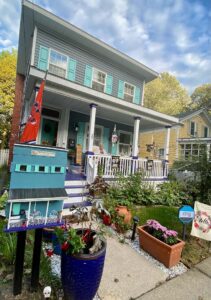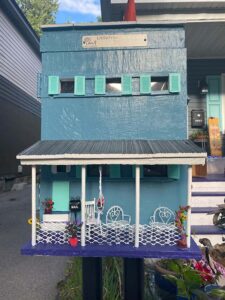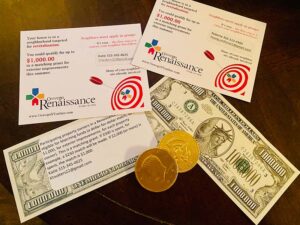By Tim Nekritz
nekritz@gmail.com

is director of news and media for SUNY Oswego, where he spearheads telling the stories of the campus community.
It’s easy to talk about making your neighborhood better, but the Oswego Renaissance Association puts their money where their mouth is — as a record number of homeowners (me included) learned in 2021.
Some of us even took the level of commitment one step further, serving as block captains to try to bring together fellow homeowners for cooperative grants that stretched through an impressive 20 city neighborhoods. This patchwork represents a grassroots approach to improving our neighborhoods one home at a time.
And while a pandemic, supply-chain issues and a labor shortage made 2021 a year of unique challenges, the ORA’s neighborhood program still achieved unprecedented success.
In 2021, 183 participating Oswego homeowners and landlords completed Renaissance Block Challenge Grants, working block by block to renew neighborhoods; Renaissance Downtown Challenge Grants, to create attractive open-air seating in support of a vibrant business climate; Paint Oswego Grants to make their homes brilliant via historic painting combinations; and Pride Grants that seed neighborhood development.
For last year, ORA calculated $682,636 invested in homes and neighborhoods through these programs.
The nonprofit organization’s grand tally is more than $4.35 million in private investments through these programs into Oswego’s Renaissance Block neighborhoods.
In some cases, projects not only improve a neighborhood’s present and future, but recast it from its past.
Consider the neighborhood historically known as “The Flats,” the city’s westside area downhill from West Fifth, bordered by Bridge Street and the Oswego River.
During the city’s maritime heyday in the second half of the 19th century into the early 20th, The Flats was a place where sailors and people passing through could find anything they wanted. And I do mean anything — alcohol, stimulants, depressants, companionship, entertainment or other amenities.

To a degree, that past and long-standing identifications have hung like a hangover that sometimes hampered ability to develop these neighborhoods and garner investments.
While West First Street, Water Street and the linear park have generally remained amenable promenades in recent decades, and further inland has had some success among blocks and businesses, you could also see plenty of blight and declining housing stock. The idea of potential to push beyond a problematic past makes it an ideal ORA area.
And in Roberta and Rodrick Andrews, The Flats found nearly ideal ambassadors sharing block captain duties with longtime community member Katie O’Leary.
When civic leaders talk about attracting young professionals looking to energize their neighborhoods, the Andrews are just about perfect. They came up from Florida when Rod accepted a job as SUNY Oswego’s director of financial aid, while Roberta is a longtime executive with Hilton, now general manager of its Homewood Suites in Syracuse.
ORA director Paul Stewart, who lives not far away on West Fifth Street, reached out to the Andrews, and they immediately saw it as a way to meet people, particularly their new neighbors.
“We moved here around the time COVID hit, so we didn’t have a chance to make the connections we normally could,” Rod explained.
“We saw it as an opportunity not only to make our own property better but really help neighborhood pride and build relationships,” Roberta said.
‘While a pandemic, supply-chain issues and a labor shortage made 2021 a year of unique challenges, the Oswego Renaissance Association’s neighborhood program still achieved unprecedented success.’
The grant process involves collecting at least five neighbors (the more the merrier) to commit to improving their homes or properties in ways that will enhance their environs. These are matching-fund projects reimbursing up to $1,000 per property or $1,500 for corner lots. If you do $2,000 worth of planting and front-facing painting, for example, you can receive $1,000 in reimbursements, but even spending less than that on flowers to brighten your yard is still a fundable contribution.
It’s worth noting that, in addition to homeowners, these applications are open to landlords and tenants, incorporating anybody and everybody who wants to invest in better neighborhoods.
Meeting your neighbors
With O’Leary’s local knowledge and the Andrews’ enthusiasm, the team signed up 23 properties for ORA’s Neighborhood Block Challenge. The team worked on the stretch of West Fourth Street between West Park and Lake Ontario, also swinging a little onto nearby West Van Buren Street.

“Paul was terrific in encouraging us, and Katie did a phenomenal job,” Roberta said. “She really knows the people in our neighborhood.”
For my stretch of West Fifth Street, we lined up 16 properties to participate in a variety of ways.
But just getting to that part isn’t always easy. You can’t really go door to door in a pandemic. You can’t easily invite people over to your kitchen or living room for meetings. And in the 21st century, many of us busy folks simply don’t know our neighbors the way you see depicted in mid-20th century movies and TV shows.
Which is to say, I’ve lived in my neighborhood in the southwest part of the city for nearly 20 years and it was embarrassing to realize how few of them I knew beyond their names (even if I knew that much). And granted, some places are apartments with regular turnover, but beyond a weary acknowledgement when we’re out shoveling snow at the same time, I really hadn’t connected with them beyond a surface level.
I decided to buy a set of cards and envelopes — figuring they might stand out more than letter-sized mailings — and painstakingly wrote notes to my neighbors as legibly as possible.
In researching who owned what property in my zone along West Fifth between Prospect and Varick, I learned many of their names for the first time. The majority of them were receiving cards from a random stranger with a quick message about an effort they may or may not have heard of and my contact information. In terms of direct-mail marketing, the level of interest was rather phenomenal.
The Andrews were even more creative. They sent packages to neighbors with play money and toy coins to bring home the point about getting money to improve your place. Seeing pictures of the packages, I don’t know how anybody wouldn’t feel part of the excitement and at least want to learn more.
Throughout The Flats, West Fifth and all the other neighborhoods, people painted, planted, upgraded porches and did other projects large and small to inject life and joy into the neighborhoods.
Porch life
I was honored that the Andrews invited me to play on their porch for PorchFest, where a collection of curious onlookers provided an amazing vibe on an early Sunday afternoon. PorchFest started out several years ago unfolding up the hill in the established upscale Franklin Square District, so some acts reaching down into The Flats was more than a little symbolic in terms of inclusion.
For the Andrews, their upgrades included painting their porch, new flags and lighting, exterior upgrades and a little free library that looks exactly like their house. “This house has had a lot of love and a lot of families in here,” Rod said. “We feel like we’re caretakers more than homeowners.”

Block Challenge participants ranged greatly in execution. Many made extensive positive changes — you submit before and after photos, and some are quite remarkable — while some made modest improvements.
Since I decided to buy the former Swiatlowski’s grocery store just down the block and which also was in our ORA zone (see previous column for details), I had to split my attention, but put in a surprisingly successful raised-bed garden and other landscaping, and improved porches in both places.
In case you haven’t noticed, porches are a recurring theme. They are the primary common area between homes and neighbors, an intermediary space that is both public and private where conversations and connections can take place. A good porch where you can sit and interact is the gateway to being a good neighbor and establishing a friendly neighborhood.
The ORA grants expand those connections from porches into the spirit of neighbors helping neighbors, as the organization encourages people to share expertise and tools with others to make things people didn’t realize might be possible come to fruition.
Neighbors helping neighbors
“It takes it beyond ‘what can I do to improve my home?’ to ‘what can I do to help my neighbors?’” Rod said.
In addition, the application asks for, and grants, up to $1,000 for some kind of neighborhood activity and project that brings the area together. These traditionally range from block parties to decorative street signs to corner common gardens. The Andrews, of course, wanted to get creative — while encouraging interactivity.
“We decided to have a gathering for pumpkin decorating around Halloween,” Roberta said. “The neighbors went all out to decorate jack o’lanterns. It was a fun way to celebrate our success and all get together.”
“We’ve seen people who didn’t even participate in this round doing things, just feeling more pride,” Rod noted.
“We have so much gratitude for the opportunity and for our neighborhood,” Andrews said. “It’s so exciting to see what’s next. This is only the beginning.”
For more information on becoming a captain or joining a Neighborhood Block Challenge — or learning about other funding available to support property improvements in the city of Oswego — visit the ORA website, oswegonyonline.org.


